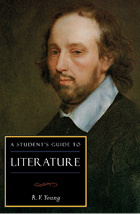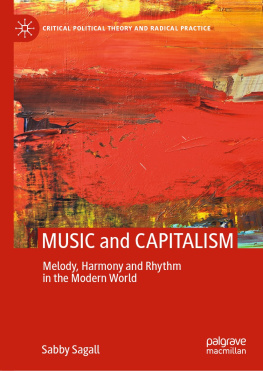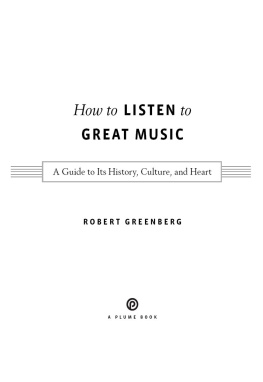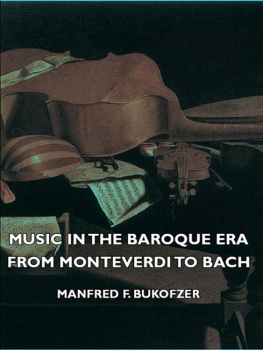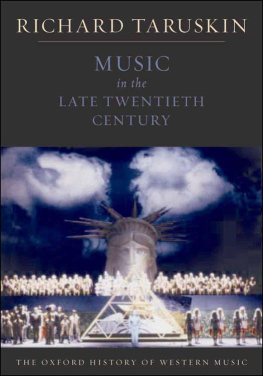THE PRESTON A. WELLS JR. GUIDES TO THE MAJOR DISCIPLINES
EDITOR
Jeremy Beer

PHILOSOPHY Ralph M. McInerny
LITERATURE R. V. Young
LIBERAL LEARNING James V. Schall, S.J.
THE STUDY OF HISTORY John Lukacs
THE CORE CURRICULUM Mark C. Henrie
U.S. HISTORY Wilfred M. McClay
ECONOMICS Paul Heyne
POLITICAL PHILOSOPHY Harvey C. Mansfield
PSYCHOLOGY Daniel N. Robinson
CLASSICS Bruce S. Thornton
AMERICAN POLITICAL THOUGHT George W. Carey
RELIGIOUS STUDIES D. G. Hart
THE STUDY OF LAW Gerard V. Bradley
NATURAL SCIENCE Stephen M. Barr
MUSIC HISTORY R. J. Stove
A StudentsGuide to Music History
R. J. STOVE

W ILMINGTON , D ELAWARE
All rights reserved, including without limitation the right to reproduce this ebook or any portion thereof in any form or by any means, whether electronic or mechanical, now known or hereinafter invented, without the express written permission of the publisher.
A Students Guide to Music History is made possible by grants from the Lee and Ramona Bass Foundation, the Huston Foundation, the Lillian S. Wells Foundation, the Barre Seid Foundation, and the Grover Hermann Foundation. The Intercollegiate Studies Institute gratefully acknowledges their support.
Copyright 2007 by Intercollegiate Studies Institute
Cover design by Sam Torode
ISBN: 978-1-4976-4508-0
Published by ISI Books
Intercollegiate Studies Institute
3901 Centerville Road
Wilmington, DE 19807-1938
www.isibooks.org

Distributed by Open Road Integrated Media, Inc.
345 Hudson Street
New York, NY 10014
www.openroadmedia.com

CONTENTS

TO MY DEAR NEPHEWS, JIMMY AND HUGH
History is the essence of innumerable biographies.
Thomas Carlyle (17951881)
One intellectual excitement has been denied to me. Men wiser and more learned than I have discerned in history a plot, a rhythm, a predetermined pattern. These harmonies are concealed from me.
H. A. L. Fisher (18651940)
PREFACE

AS THE EARLY Christian apologist Tertullian might have said, this volume exists because it is impossible. The brief from ISI Books: to supply a student guide to Western classical musics history, a guide that would avoid both orgiastic one-upmanship and insults to the adult intelligence; moreover, to keep this guide within the word limits of its ISI series companions. The response of almost any sane author to having been offered this brief: pleasure and terror indissolubly combined.
Perhaps only P. J. ORourke, with his sublime knack for discarding whole millennia of human history in a sentence or two (Man developed in Africa. He has not continued to do so there),century guide, tourism analogies are relevant. A package tour satisfies to the precise extent that it admits to being a package tour and does not pretend to be a pilgrimage or year-long sabbatical. When such satisfaction occurs, travelers may well find themselves rushed, but they cannot complain of being deceived. (Berkeley-based musicologist Richard Taruskin required six volumes and 4,252 pages for his 2005 Oxford History of Western Music. He still had to economize on various topics, particularly since he devoted two entire volumes to the twentieth century.)
The present books resemblances to a package toura well-organized one, let us hopewill be obvious. Word limits enforce not simply depth limits, but range limits. What follows is necessarily, and therefore defiantly, Eurocentric. Where it ventures outside Europe at all, it mainly sticks to the United States. The whole phenomenon of artistic postcolonialism has inevitably been sidelined. So, still more unfortunately, has most nonclassical music: for space reasons, rather than through any latter-day desire for high-cultural gatekeeping.
Yet why (it might be asked) have a history, however brief, of classical music in the first place? After all, millions of sincere music-lovers derive genuine pleasure from their listening without any historical consciousness whatsoever. Australian discographer John L. Holmes observed in 1982: A vast number of concert-goers have, I am amazed to find, an extraordinary ignorance... even of the common facts of musical history, and are puzzled
Possibly within Lamberts pungent phrase lies the best answer to the question of why anyone should bother with music history. Aural tickling, by definition, is evanescent in the pleasure it furnishes. A certain historical awareness gives, as it were, a three-dimensional effect to what one hears. It imparts the element of the composers individual humanity; it banishes the assumption that the music concerned is a mere exercise in pattern-making. This is not a plea for biographical voyeurism, after the manner of tabloid hacks. It is merely a plea for the life of the whole mind, for an end to the spiritual short-changing that comes from doing without historical knowledge in musical matters: or, worse still, from an active hostility to historical knowledge.
One innate problem afflicts any musical chronicle. No one historian can muster the same affection for every composer whom he describes. Frequently he finds himself endorsing Oscar Wildes dictum: only an auctioneer can equally and impartially admire all schools of art. Readers of the following will discover that, now and then, the present authors judgment on a specific recent creator defies todays consensus. They are merely asked to believe that musical posterity is a bitch-goddess, repeatedly damning even the most honored composers of a particular epoch. A hundred and fifty years ago, such currently obscure figures as Giacomo Meyerbeer and Fromental Halvy stood unchallenged among compositions supreme immortals. During the same period, Johann Nepomuk Hummel and Louis Spohr were widely thought to surpass Beethoven. It is presumptuous to suppose that certain highly touted individuals of more modern times (particularly if their fame rests primarily on agitprop of nonmusical origins) will be any more impervious than were Meyerbeer, Halvy, Hummel, and Spohr to the turns of Fortunes wheel.
Inspiring genuine regret is the material that must be skimped. A chronological cut-off point has been, reluctantly, imposed. The coverage concentrates on those musicians who achieved at least national fame before 1945, with a brief epilogue essaying the futile task of summarizing post-1945 developments. When gripped by remorse over those deserving composers who have had to be slightedor, too often, omitted altogetherone is tempted to embark on another book, simply to give these individuals adequate room. Meanwhile, the appended bibliography should help in furnishing information kept, perforce, out of the text proper. May it, and the guide itself, lead to a renewed kindling of enthusiasm by readers for the subject: because any writing on music which fails to generate musical enthusiasm is done in vain.

